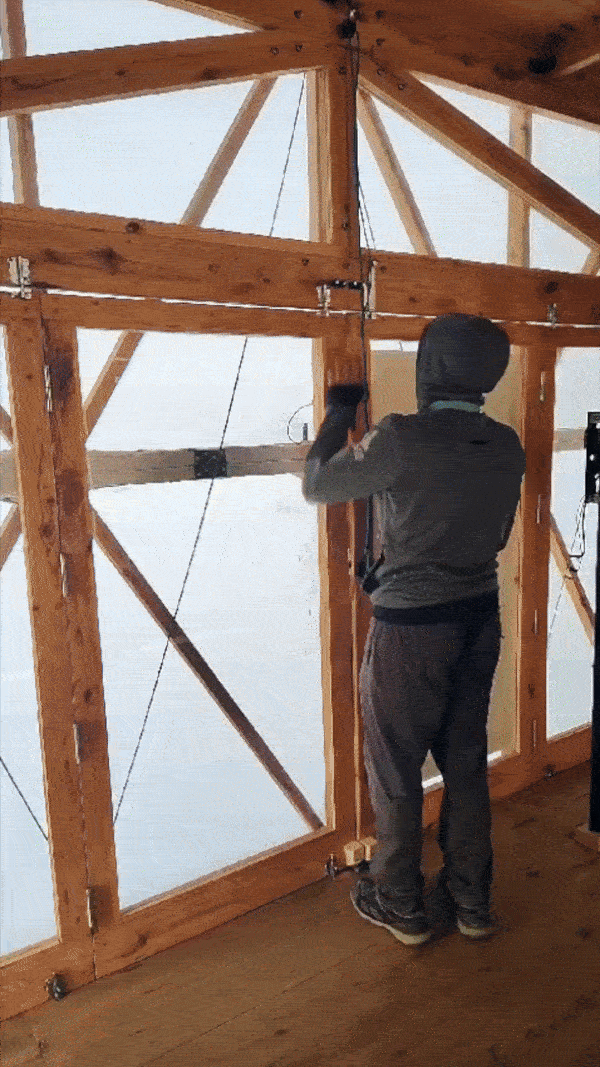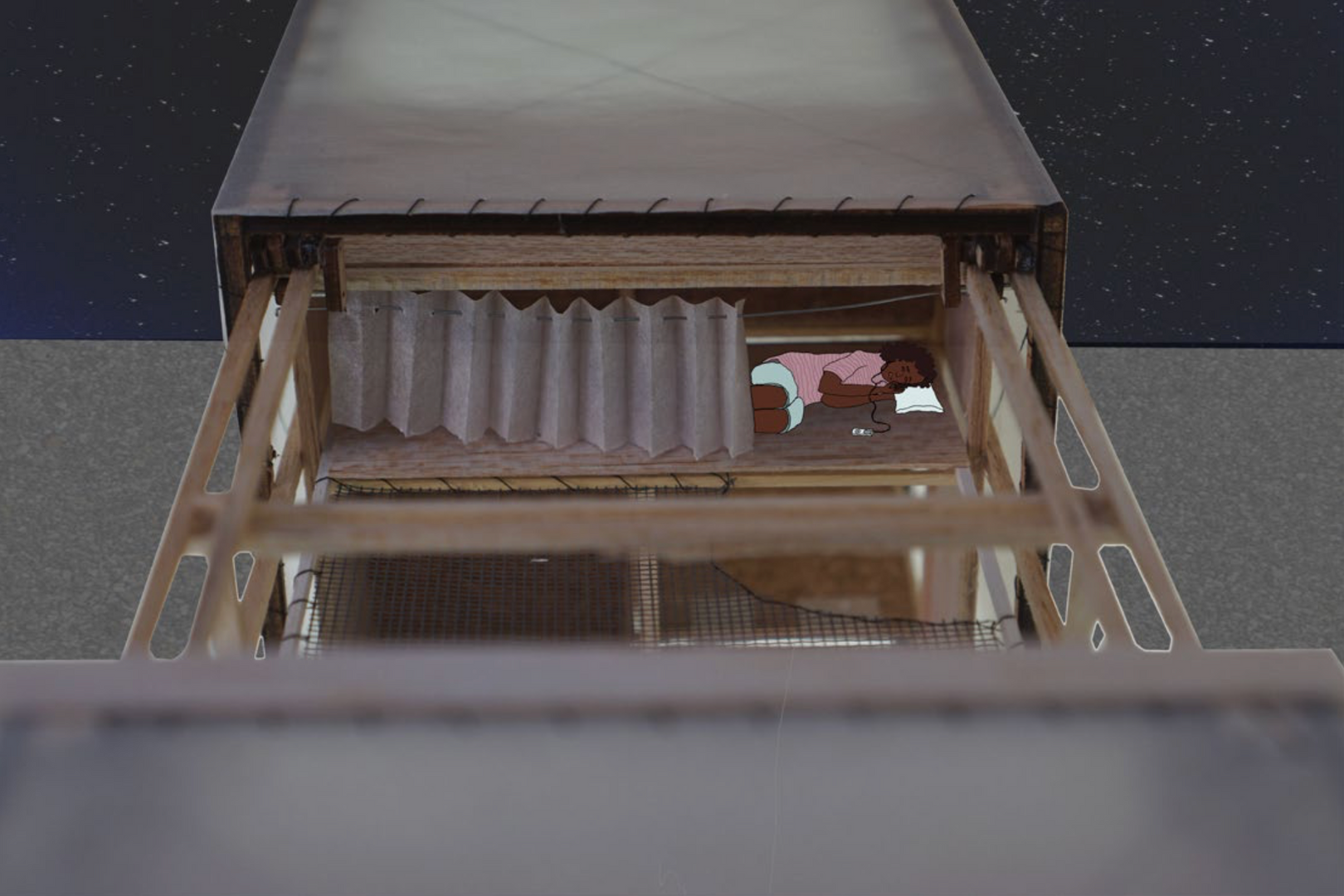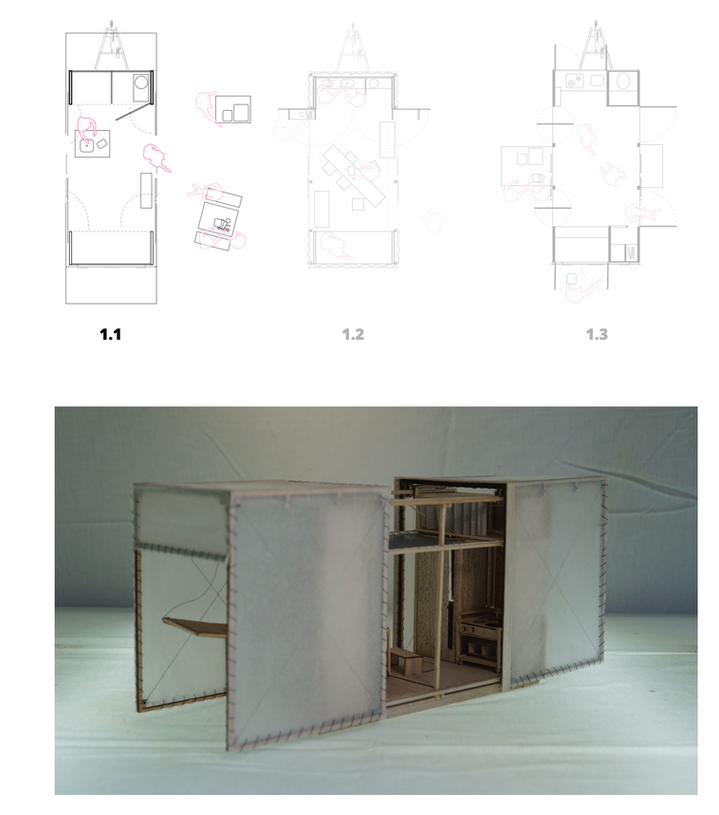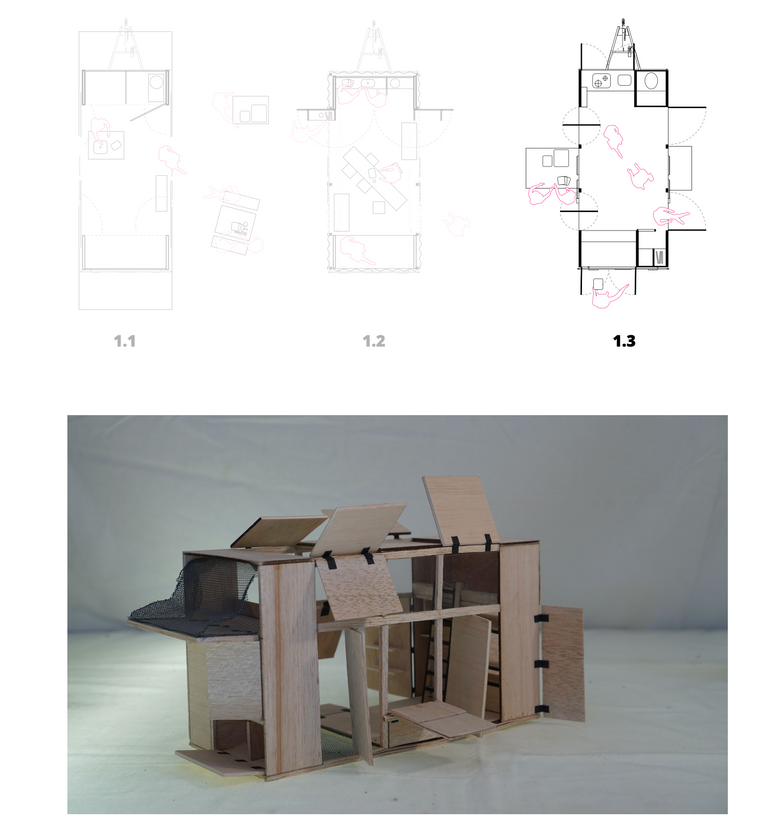

Energy System
The Mo.ca Mobile House is self-sustaining in its energy needs, using a
solar-powered system designed to meet the requirements of both living and
hosting social events. The energy system consists of:
-
Three 175W solar panels,
-
A 300Ah 12V lead-acid battery,
-
And an inverter that automatically turns on/off when any of the 230V outlets are in use, saving conversion energy when not in use.
The system powers internal 230V power plugs as well as 12V USB hubs, ensuring flexibility for a variety of devices. The 12V appliances, such as lights and water pumps, are connected directly to the battery without requiring conversion, ensuring efficient energy use.
The system is calculated to sustain the energy needs (such as power for phones, laptops, lights, and water pumps) for two people living in the trailer for up to two days without sunlight. Additionally, the system supports hosting social events, powering speakers, a large TV, a projector, and laptops
for workshops and gatherings.
For long-term stays in areas without sunlight, the consumer box can be connected to an external power supply. The combination of solar energy, flexible infrastructure, and smart energy management makes the Mo.ca Mobile House a versatile and
self-sustaining solution for both domestic and community use.
Mo.Ca.
The Mo.ca Mobile House was developed by IAAC at Valldaura Labs as a fully self-sustaining, mobile structure built using locally sourced wood. The house is constructed with CLT (Cross-Laminated Timber) panels, which are connected using wood dowels instead of glue to enhance sustainability. This construction method not only reduces the use of harmful adhesives but also enhances recyclability for after-live assessment.
The house is self-sustaining in its energy (using solar power) and water, featuring a water filtration system thatrecycles water and can tap into local natural water bodies. It can accommodate 2 to 4 people, with two extendable double beds, a bathroom with a shower and toilet, and a kitchen equipped with a stove and fridge. It also includes multiple 230V outlets for energy needs. In addition, the Mo.ca Mobile House is also equipped with mobile furniture, offering flexibility for domestic use and hosting events or workshops.
Its adaptable façade and multifunctional interior make it ideal for deployment in underutilized spaces, where it can provide crucial infrastructure like energy and water. Mo.ca stands for "mobile catalysis," reflecting its mission to reactivate spaces and support social and cultural events through sustainable, flexible infrastructure.

Water System
Water management is one of the most significant challenges for self-sustainability, particularly in mobile structures like the Mo.ca Mobile House. While solar energy can be harnessed anywhere outdoors, water cannot be generated and is not always accessible. This makes water recycling essential for extending the period for which the mobile home can operate independently. The Mo.ca Mobile House has multiple tanks to store and manage water efficiently. The kitchen tap and shower do not use traditional warm or cold water systems but instead, draw from fresh and recycled water tanks. Additionally, the kitchen tap has access to a third tank containing drinking water, ensuring clean water for consumption. The reusability of water significantly extends the time the house can remain self-sufficient, allowing it to function for more extended periods without needing external water supplies.


Water Interface
Mo.Ca. features an intuitive water system interface to help users make informed decisions about their water consumption. Indication lights on the tap and shower show the levels of different water sources—fresh water, recycled water, and blackwater—allowing users to manage their resources effectively.
Sensors in the tanks display whether the levels are complete, medium, or low. As fresh water is used, the recycled water tank fills, giving the user clear feedback. For example, when freshwater runs low, users can opt for a longer recycled water shower, followed by a short rinse with fresh water. The recycled water is continuously filtered and reused, making it an almost endless resource, except when it turns blackwater.
The kitchen tap has a separate drinking water spout for safety, ensuring drinking water is never mixed with fresh or recycled water. Additionally, a red LED flashes when the blackwater tank is full, signaling that it needs to be emptied. This system provides real-time insight into water usage, helping users extend their stay before a refill is necessary.
Water Shelf
All water tanks and filtration systems are accessible via the "water shelf" located at the back of the trailer. This water shelf acts as the central hub for managing the Mo.ca's entire water supply. It offers easy access for refilling the tanks and includes a water hose connection for drawing water from external sources like natural water bodies or collected rainwater. Beyond its refilling capabilities, the water shelf also contains the "brain" of the system, which controls the various electronic sensors responsible for monitoring water levels, activating the filtration system, and ensuring the smooth and automated functioning of all water-related processes. This centralized system makes water management straightforward, giving users complete control over their water resources—whether they are recycling greywater or tapping into external sources



Greywater
Filtration System
The Mo.ca Mobile House incorporates an advanced greywater recycling system that maximizes water reusability. Water used in the shower is collected in the shower basin and directed into a storage tank. Sensors monitor the volume of water in the storage tank, and once a certain level is reached, the filtration system is automatically activated. This system pumps the greywater through three filters designed to remove particles, oils, and other pollutants. After passing through these mechanical filters, the water is further treated in a CVC filter, which biologically disinfects it. The clean, recycled water is then stored in the recycled water tank, ready to be reused by turning the kitchen or shower taps to the warm setting. This setup ensures that water can be used multiple times, significantly reducing waste and enhancing the self-sufficiency of the house


Filtration of
Natural Water Sources
To make the Mo.ca Mobile House even more adaptable, the filtration system includes a valve that allows the system to switch between internal greywater recycling and collecting water from external sources. By attaching a hose to the system, water can be sucked in from local natural water bodies or collected rainwater. The water is then processed through the same filtration system, ensuring it is clean and safe for reuse. This capability gives the mobile house flexibility in diverse environments, allowing the tanks to be refilled without relying on traditional water supplies, thereby enhancing its autonomy.
Material Sourcing
Mo.Ca. is constructed from locally sourced wood harvested from the forest surrounding Valldaura Labs. This wood was locally dried, cut, planed, and assembled into DLT (Dowel Laminated Timber) plates, using wooden dowels instead of glue, making the structure more sustainable. This method ensures structural integrity and minimizes the use of chemicals and adhesives.
In addition, pine tar varnish was produced from the wood's offcuts. This environmentally friendly varnish protects the wood using natural resources from the same forest.
To accurately assess the project's carbon footprint, all parts used were separated by material type, and travel distances were tracked. This allowed the calculation of the total carbon released during the project and the carbon stored in the wood.
As a result, the Mo.ca Mobile House achieved a negative carbon footprint, meaning it stores more carbon than it releases.
Social Design
& Models
The social design concept of the Mo.ca Mobile House is rooted in the idea of serving as a social catalyst to reactivate underutilized or remote spaces. By providing essential mobile infrastructure, such as independent energy and water systems, Mo.ca creates the opportunity for spaces to host social events, cultural residencies, and workshops in places that might otherwise lack these resources. The flexible and self-sustaining structure allows Mo.ca to be moved and adapted to different environments, encouraging community engagement, cultural exchange, and collaboration.
Its design facilitates the transformation of dormant spaces into
lively hubs for creativity, learning, and social interaction. Its ability
to offer infrastructure on demand catalyzes new possibilities for
local communities and visitors, fostering connections that may not have been possible otherwise. In this way, the Mo.ca Mobile House is more than a building
—it is a mobile platform for social activation, aiming to inspire creativity, inclusivity, and collaboration wherever it goes.






























